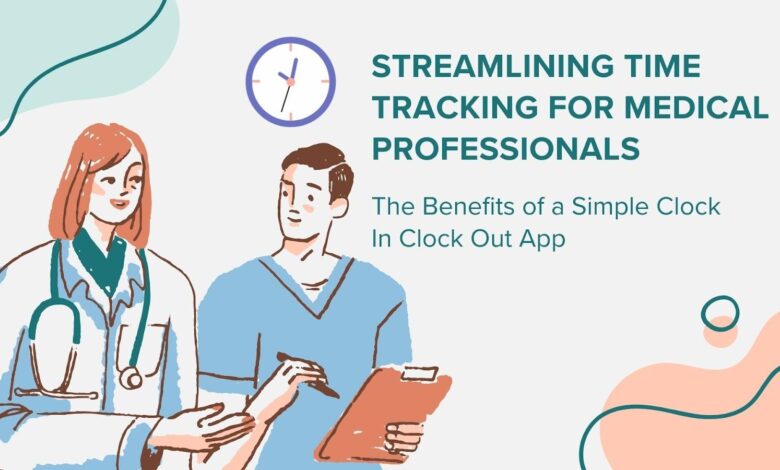Streamlining Time Tracking for Medical Professionals: The Benefits of a Simple Clock In Clock Out App

Accurate time tracking although critical is often overlooked in running a successful healthcare organization. With increasing costs and slim profit margins, medical facilities need to optimize their labor management more than ever. Manual and outdated time-tracking methods simply won’t cut it anymore.
Implementing a simple automated time-tracking solution like a clock-in clock-out app can transform operations completely. This will change the way your medical facility monitors, manages, and reports staff hours. So to help get a better handle on this, in this blog post, we’ll discuss the key reasons healthcare administrators should embrace this technology.
The Urgency of Accurate Time Tracking in Healthcare
Time is money, especially in the healthcare industry. Doctors’ and nurses’ time is highly valuable and directly linked to billing, reimbursements, and revenue.
Without proper time tracking, medical facilities run the risk of losing revenue and missing out on billable hours. Payroll errors also become common when time records are inaccurate, leading to staff dissatisfaction over incorrect pay.
Implementing a simple automated time-tracking solution like a simple clock-in clock-out app can transform the way your medical facility monitors, manages, and reports staff hours. In this blog post, we will discuss the key reasons healthcare administrators should embrace this technology.
On top of financial risks, poor time tracking also poses regulatory and compliance risks. Healthcare providers must adhere to strict labor laws related to overtime, breaks, schedules, etc. Detailed attendance logs are essential for proving compliance during audits.
Lawsuits over wage disputes and labor regulations are not uncommon in healthcare, making accurate time records a must.
Furthermore, proper time tracking is key to understanding and improving staff scheduling, operational bottlenecks, resource allocation, and other workflows.
With tight margins and round-the-clock operations, optimizing labor utilization is essential for healthcare facilities. Robust time-tracking analytics provide the insights needed for better decisions.
The Pitfalls of Traditional Time-Tracking Methods
Most medical facilities continue using traditional manual methods of tracking employee hours, such as paper timesheets, punch cards, and logbooks. However, these methods are extremely prone to errors, buddy punching, and time theft.
Staff work long shifts and often skip breaks, but paper timesheets only show rounded hours worked. This leads to inaccuracies in pay and missed revenue from unlogged hours. Writing hours on paper also leads to accidental errors which can be hard to find and correct later.
Unfortunately, time theft and buddy punching are common with paper tracking. Employees may fudge hours, falsify records, or punch in for absent colleagues. A 2016 survey found that 75% of employees admitted to time theft, highlighting the prevalence of this problem.
These outdated approaches simply do not provide the level of accuracy, accountability, and analytics needed for robust workforce management in healthcare. That’s where modern technology comes in.
The Technological Solution: Clock-In Clock-Out-Apps
Clock-in clock-out apps are a handy way to keep track of your work hours digitally. These apps work right from your smartphone, using GPS to mark when you start and finish work. So, when you arrive at work, you can easily clock in using the app, and it will record the time and where you are.
As you go about your day, the app keeps track of the hours you work without you having to do anything extra. When it’s time to leave, you can simply click to clock out. The app then sends this time information to the cloud immediately.
This means that you, your managers, and administrators can all see this data right away, without needing to type it in manually.
A cool thing about many of these apps is that they can connect directly to payroll systems and EMR software.
This helps make getting paid easier and reduces the need for lots of paperwork. Some of the more advanced apps even give you helpful information about your work hours and schedule. This way, managers can make smarter decisions based on the data.
Benefits of Clock-In Clock-Out Apps
- Eliminates “Rounding Up”
Tracking hours worked down to the minute is easily possible with clock-in and clock-out apps. No more rounding up time to the nearest 15 minutes or half hour. This prevents payroll inflation and missed revenue from unlogged minutes.
- Minimizes Data Entry and Errors
By removing manual entries, errors due to mistypes or falsifications are eliminated. Payroll teams save hours of time on administrative tasks. The risk of transcription errors is also gone.
- Deters Time Theft and Buddy Punching
Since the app tracks location and times, employees cannot falsify records for themselves or colleagues. Timestamped GPS data provides verification and accountability.
- Enables Real-time Alerts and Overtime Tracking
Managers can set up real-time alerts for overtime, late check-ins etc. This allows proactive management of schedules and labor costs. Time auditing also becomes easier.
- Provides Robust Analytics and Insights
Administrators gain access to rich analytics for data-driven scheduling and operational decisions. Trends like peak hours, overtime triggers, absenteeism, etc. can be identified.
- Facilitates Regulatory Compliance
Detailed timestamped records help demonstrate compliance with healthcare labor regulations during audits. Disputes over hours are easily resolved.
Ensuring Compliance and Security
When implementing a time-tracking app, security and compliance are key considerations for healthcare organizations. Protecting sensitive patient data is imperative.
Reputable apps invest heavily in data security and access controls. Encryption, role-based access, and remote wipe capabilities minimize risks. HIPAA compliance and other certifications should be evaluated.
For added assurance, biometric punch-in options, mandatory geo-fencing, and automated anomaly alerts provide additional layers of protection against time theft. Activity logs also offer transparency over edits.
Implementation Best Practices
Following best practices during adoption ensures smooth adoption and maximum impact:
- Provide in-depth staff training on the proper use of the app. For this, making use of weekly reminders helps reinforce this training.
- Start with a pilot group before the company-wide rollout. This allows for working out any kinks and bugs that may arise in everyday operations.
- Monitor clocks ins/outs daily for the first month to ensure policy compliance. Follow up on any issues immediately, this way they can get sorted out as soon as possible.
- Customize overtime and lateness policies in the app to align with existing workplace rules.
- Integrate the app data with payroll and HRIS systems for added convenience.
- Appoint administrators to monitor analytics dashboards and spearhead improvements.
Case Studies
Jefferson Healthcare, a community hospital network in Washington state, adopted the TSheets time tracking app in 2018 across their multiple facilities.
Within months, they experienced a 67% drop in time tracking errors and late payroll. Overtime costs were also reduced by 15% due to real-time alerts enabling proactive adjustments.
Similarly, Arizona Digestive Health implemented the Homebase app for its staff of over 100 physicians, nurses, and support staff. Previously, up to 15 hours per week were spent on payroll reconciliation and overtime monitoring. The app reduced this administrative burden to less than 1 hour per week, a massive improvement.
These are just two examples of the measurable benefits and labor cost optimizations healthcare providers have gained from clock-in and clock-out apps.
Frequently Asked Questions
- How Secure Are These Apps in Protecting Sensitive Healthcare Data?
Data security is the number one priority for reputable time-tracking apps catering to the healthcare sector. End-to-end encryption ensures timesheet data remains private and compliant with HIPAA regulations. Role-based access controls and remote wipes of lost devices further minimize risks. Before adoption, thoroughly vet the app’s security infrastructure to know if it’s the right fit.
- What Happens If the App Fails or There Are Technical Issues?
Redundancy plans are essential even with the most robust apps. For short-term failures, a simple paper timesheet backup could be the contingency. For longer outages, the API or data can be exported as needed to payroll systems. Some apps have “offline mode” features allowing continued use without live internet connectivity.
- How Do These Apps Integrate with Existing Healthcare Management Systems?
The best time-tracking apps offer native integrations or APIs to connect with EHR software, payroll systems, HR platforms, etc. This allows easy transfer of data without manual re-entry. Zapier and IFTTT can also be used to set up custom integrations between various healthcare management systems.
Bottom Line
In today’s complex healthcare environment, optimizing labor productivity and accuracy is critical. Clock-in-clock-out apps provide a simple yet powerful solution to the antiquated methods holding back too many medical facilities.
Intuitive, automated, and integrated – it’s time for healthcare administrators to embrace these tools for streamlined workforce management. The benefits range from increased revenue, lower labor costs, and better compliance to improved analytics for data-driven staffing decisions.
Don’t let time tracking remain an afterthought. Instead, unlock its potential as a strategic advantage with the right technology.



